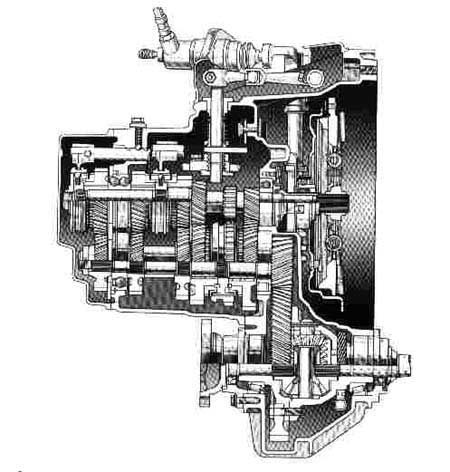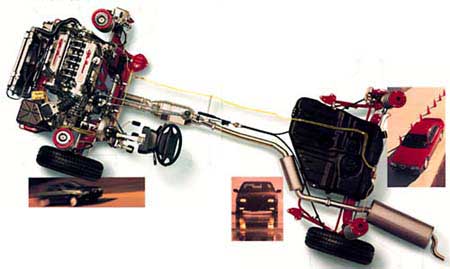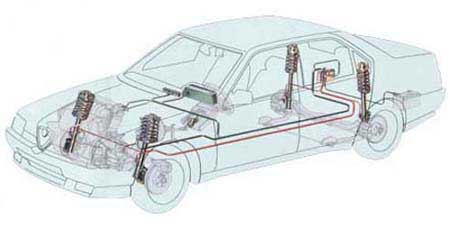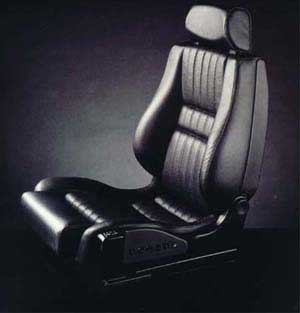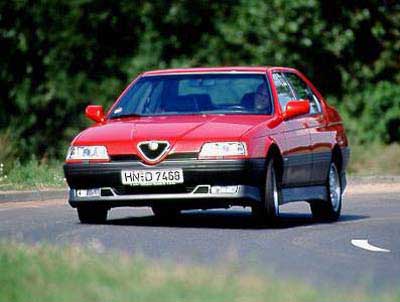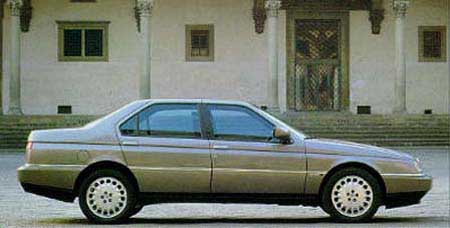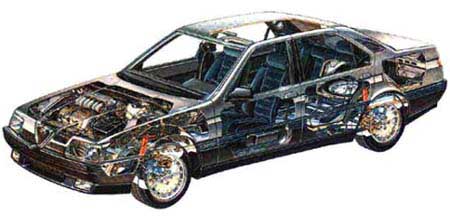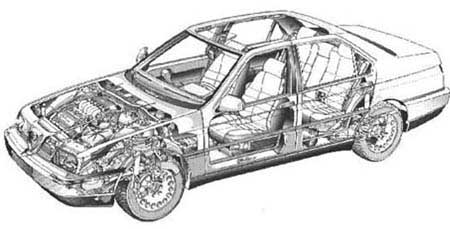Buyers Guide Alfa Romeo 164
Introduction
The Alfa Romeo 164 was
introduced to the italian market in 1987. It was the first car which
appeared on the market after Alfa Romeo was taken over by Fiat. It was also
the first consequently developed upper-class limousine from Alfa Romeo.
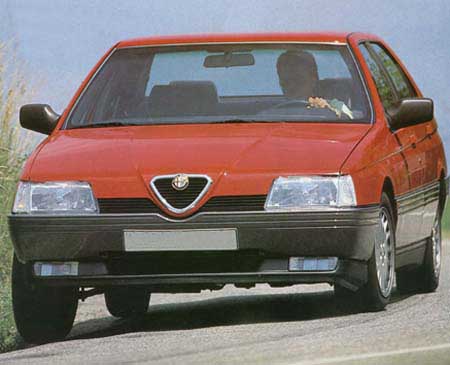
The basic concept of the 164, internally called Tipo 4, was developed together with Fiat/Lancia and Saab before Alfa was taken
over by Fiat. However, the first official deliveries in Germany started at the beginning of 1988. Alfa Romeo and the mother company Fiat wanted to solve
all minor technical problems of the new model and raise the quality to an adequate standard. After all, the 164 should ensure the economic
survival of Alfa Romeo for the future.
The coachwork designed by Pininfarina, shows an ageless and elegant formed body with a low front
which softly rises into a fashionable high rear end.

Besides the well known 3.0 l V6 SOHC engine with 184 bhp (192 bhp without 3 way cat), Alfa offered the 2.0 l DOHC-TwinSpark with 143 bhp which was also in the Alfa 75 (introduced 1987) and a 2.5 l
4-cylinder turbocharged Diesel engine with 110 bhp, which was bought from the former Italian public enterprise VM. The 2.0 l DOHC 4-cylinder turbo-engine with 175 bhp which was "borrowed" from the Lancia Thema, this was in fact
based like the 164 on the Tipo 4 platform and played no great role in Germany. This engine complemented the engine range.
Model history
Additional to the 1991 model the 164 QV (Quadrofoglio Verde - cloverleaf) was introduced as the top model. It was equipped with a tuned up 200 bhp version of the 3.0 V6 engine.
1991 a new 2.0 l SOHC V6 turbo-engine with 204 bhp was introduced to the market, superseding the 4-cylinder turbo-engine. On all 1991 models the geometry of the front axle had been improved to avoid driving forces affecting the steering system.
1993 the "Super"-models have been launched. Besides a thorough face lift - internal and external - the new 24 V engines were introduced. These engines based on the SOHC V6, but had 4 valves per cylinder and two overhead camshafts for each cylinder bank.
The power output was 210 bhp.

The QV-models also were equipped with the above mentioned engine. Again, as with the first 164 QV's, a tuned up version of the engine was used. The QV's reached a max power output of 234 bhp.
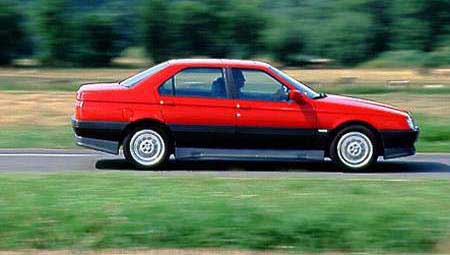
The basic models were produced with the original model names for another year. They had exactly the same standard as the Super models, but were not equipped with the 24 V engines. The 24 V engines were only available in the Super models. You can
clearly spot these models, internally called 164 "FL" (where FL stands for Facelift), by the special DE-projection-headlamps.
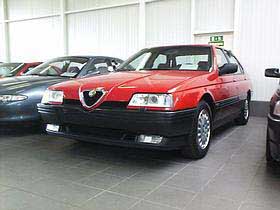
To reach a lower "emission classification" the 3.0 litre V6 12V engine became a new engine software, which reduced the power output from 184 bhp to 180 bhp. In many countries
the technical authorities measure the cars emissions before permission to import or sell cars of the tested type is issued. A major factor is how
much hydrocarbon and carbon monoxide an engine produces through the tested rev range. According the measured figures a car is classified and therfore
emission classification numbers are used as references. Maybe you've heared about the "Euro 3" or "Euro 4" norms, which are in fact the latest
two emission classification references in Europe.
In 1994 the production of the basic models had been ended. From that date on only the Super models, the top models "QV" and the newly introduced "Q4" were produced. At the same time the turbocharged engine
was slightly modified lowering the power output to 201 bhp. The Diesel engine, still supplied by VM was tuned up and now had a power output of
120 bhp and slightly improved torque.
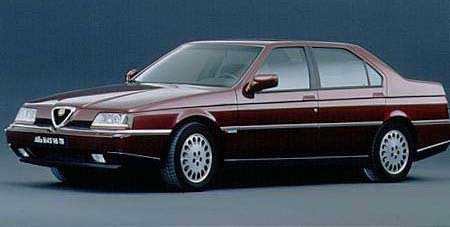
>From now on the absolute top model was the 164 Q4. This model based on the 164 QV was equipped with a Getrag-6(!)-speed gearbox and had permanent all-wheel drive.

Coachwork
The complete body was based on the "Tipo 4 platform" which was also the platform for Fiat Chroma, Lancia Thema and the Saab 9000.
Only the very early models had some problems with rust. Mainly in the wheel well area around the plastic covered inner fenders, the trunk lid, the waterdrains of the windscreen, rear window and the
optional sliding roof.
Thanks to a partly galvanized body the 164 is very well protected against corrosion. Among other things the unprotected rubber seals of the door apertures suffer when people step on
them whilst getting in or out of the car.
The outside rear view mirrors of the pre Super models up till 1993 suffered from the salt which is used in German winters to de-ice the roads and the light alloy often shows pitting.
Sometimes it happens that scruffy Super models have the same problems.
A further problem is chipped paint on the hood caused by grit or gravel or when the clear varnish peels off.
Generally these are more or less optical defects, as long as grit and gravel only cause damage to the varnish or clear varnish coat the metal will not corrode.
Some of the earlier models had problems with leaky head- and foglamps.
The fresh air inlet for the heating-blower is located behind the splashboard, underneath the thin plasticcover. Due to the necessary openings in the plastic cover it can happen that foliage,
leaves, dirt, everything that flies up from the roadsurface and water choke the water drains. If these drains are clogged then you'll have a nice and damp biotope, which after a few years will
ruin even the best galvanized panels.
Mechanics
Engines
It's well known that well treated and regularly serviced Alfa engines have a very long life. We just want to talk about the "real" Alfa engines. The turbo charged 4 cylinder
engines don't play a role in Germany. We won't talk much about the turbo-charged Diesel engines as we have no information that can be of use
for you.If you have any problems then you can contact your nearest Chrysler workshop as VM is now owned by the Daimler-Chrysler AG.The Turbo Diesel is to be found in the Cherokee and Voyager.
The TwinSpark 4 Cylinder
As a result of the weak financial background, Alfa Romeo unlike their competitors, could not afford to develop a 4 cylinder engine with a 16-valve cylinderhead. So Alfa thought back to the "good ol' times" of the
GTA era. At that time Alfa earned remarkable motor sports results against much stronger competitors, using a conventional 8-valve cylinderhead equipped with two spark plugs per cylinder and the legendary dual ignition
system. The so called TwinSpark system.
The basis for the TwinSpark engine is nothing else than the well known standard DOHC-engine. Compared to the standard DOHC-engine the TwinSpark's cylinderhead has a considerably narrower valve angle. The dual (twin) ignition system consits of 8 spark plugs, 2 ignition systems and the Motronic ( a black box
responsible for ignition timing/fuel-injection, etc.). The Motronic controls a lot of different engine parameters and governs the exact firing of each spark plug by sending signals to the ignition-systems. The two spark plugs in the particular cylinder fire slightly offset.
In comparison to other engines the TS-engine with only 8 valves has quite a high performance. This is not only due to the dual ignition system alone. Another innovative invention of Alfa Romeo is responsible for a major power increase. The patented "VIVT-System" (Variable Inlet Valve
Timing). The VIVT-system allows a variable valve timing, by moving the inlet cam shaft forward or backward. This means that the inlet valves open or close either ealier or later. This guarantees an optimum cylinder
charge and high torque through the whole rev-range.
The VIVT-system already has proven itself, as it was used in the first, Motronic-equipped, injection-engines of the Alfetta series.
Known defects on this specific engine are burned out pistons, mainly caused by the use of spark plugs with the wrong temperature range. Burned out exhaust valves caused by the same reason may also appear. Wrong valve clearence, especially when the gap tolerance is too low, may also cause burned
out valves. A weak point are the two ignition distributors, as the ignition rotors are bonded with the distributor shafts. Officially there are only complete ignition distributor assemblies available, costing around 180.- per unit. The Bosch reference number is 123433 2370 R1.
Thank god that the engines of the "Super"-types don't have this specific problem. These engines are, like the V6-engines of the last few model years, equipped with an electronic coil-ignition system without distributor, rotor and cap.
Otherwise well kept TwinSpark engines are known for their longevity. One imprortant thing is, that these engines due to their huge amount of coolant, need to be treated carefully when cold. You never should demand the engines full power or rev it to the limit before it has reached its operating temperature.

Der V6-Motor
The V6 engine is based on the 2.5 litre engine that was introduced with the Alfa 6 and the GTV 6.
These engines can reach a very high mileage with good care and regular servicing.
Concerning periodical servicing, here exists a weak point. The belt-driven camshafts, this belt has to be replaced every 60000 km. The official service and maintenance guide specifies a limit of 80000 to 120000 km, an earlier replacement
is cheaper than a complete engine breakdown caused by a torn belt. If you're in doubt cause the verification that the belt has been replaced (i.e. a service booklet and/or invoice) is missing, we strongly recommend
that you at once make an appointment with your workshop and have the belt replaced. During that work the valve clearance can be checked and adjusted if necessary.
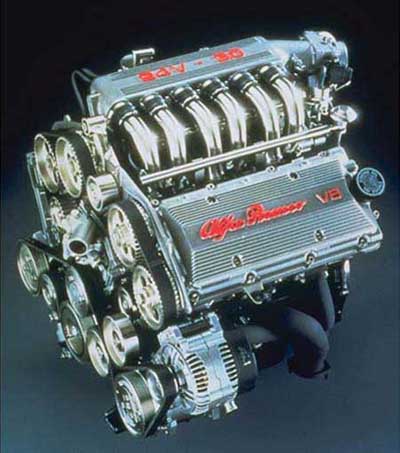
Below you can see how some parts of above mentioned engine look like when one delays the replacement of the timing belt:


Another weak spot which especially affects the older models is the timing belt tensioner. On all models before 1995, it is a hydraulic tensioner. As the oil channel between the tensioner and the engine is never hundred percent tight, it is possible that oil leaks out.
The leaked oil can damage the belt and will be sprayed all over the engine making a nice mess. However, there are conversion kits available which are mechanically operated, similar to the tensioners from the later models.
Defective waterpumps are often to be found on early models until 1990. As the timing belt has to be disassembled when replacing the waterpump, this is quite an expensive job, one should insist that in addition to the replacement of the waterpump the timing belt be replaced too.

It can happen that the turbo engine's turbocharger can be faulty. This is easily noticed by listening for strange noises and/or feeling of a decrease in power.
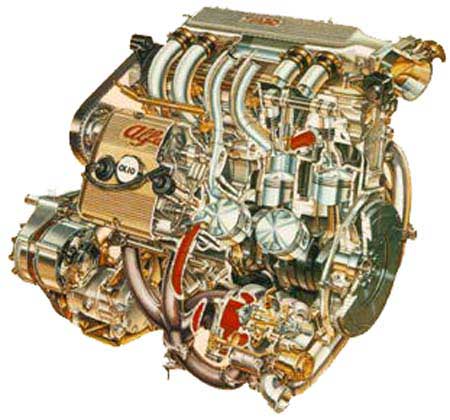
On all V6 engines it can sometimes happen that the sealing rings between valve covers and spark plug boreholes start to leak. The raised oil dust from the valve gear will then appear within the
sparkplug boreholes and around the spark plugs seats. This problem can quickly be solved by installing new valve cover seals and sealing rings. By the way, the valve cover seal of the forward cylinder bank is, due to
the construction, much easier to replace than the seal from the rear cylinder head cover.
Engines in general
Like all cars which have transverse mounted front engines, the 164's have due to the construction some weak points, which are easily solved but can sometimes be the reason for trouble. The rubber mountings of the engine wear out quickly, caused by the engine movement forces when accelerating or decelerating. This means when one accelerates the engine moves backward along the roll axis, when decelarting the engine moves back forward. This also causes damage on the flexible exhaust tubes. On the upper engine mounts only the rubber mountings wear out, but they are easy to replace. It's a different story with the flexible exhaust pipes. If they have to be replaced it is necessary to change the whole pipe leading from the exhaust manifold to the cat. The bolts which hold the cat and pipe together are always rusty and need lots of rust remover. If that does not work it is sometimes helpful to
heat the bolts with a welding torch.
A general problem of the Alfa engines with the overhead cams are the valve tappets and the camshafts. Tappets and cams on engines with high mileage often show wear. Too much wear causes pointed cam profiles, resulting in a reduced maximum engine power. If this happens the camshafts and all valve tappets have to be replaced. One camshaft for the 6-cylinder engine costs approx. 307.- (excluding costs for installation). 154.- for the 4-cylinder camshaft sound like a bargain. If during the inspection of the valve clearence it turns out that the tappets show wear, camshafts and tappets should be replaced, which will reduce costs as all the work has only to be done once.A general problem of the Alfa engines with the overhead cams are the valve tappets and the camshafts. Tappets and cams on engines with high mileage often show wear. Too much wear causes pointed cam profiles, resulting in a reduced maximum engine power.
If this happens the camshafts and all valve tappets have to be replaced. One camshaft for the 6-cylinder engine costs approx. 307.- (excluding costs for installation). 154.- for the 4-cylinder camshaft sound like a bargain. If during the inspection of the valve clearence it turns out that the tappets show wear, camshafts and tappets should be replaced, which will reduce costs as all the work has only to be done once.
Since 1993 all V6-engines are equipped with selfadjusting, hydraulic valve tappets. The engine oilpressure automatically adjusts the gap between cams and tappets (valve clearance). Therfore this system is called maintenance free. Even with this system defects can happen, there is a rattling noise coming from the valve cover when the engine is warm (operating temperature or higher). If this happens, one or more of the hydraulic tappets are defective. With cold engine a short rattling noise is normal as it takes a little time until the oilpressure inside the tappets rises.
The quality of the pistons from Alfa Romeo's supplier Borgo sometimes just can't deliver the goods, especially when the engines are knocking on. The quality of these parts was getting better as the years went by, but experts talk about a replacement of these parts after 60000 km, as they supposedly could be worn out.
Replacement pistons for the 4-cylinder engines are available from Mahle. Unfortunately the kits (pistons/liners) cost 512.-, which is almost double the price Alfa would charge for the stock Borgo parts.
Unfortunately Mahle produces no stock pistons for the 6-cylinder engines. Mondial, a subsidiary company of Mahle, can supply piston/liner-kits off adequate quality for both the 4-cylinder engines as well as the 6-cylinder engines. Experts say that they are still not satisfied, as far as quality is concerned.
A problem of all engines with high mileages are the cylinder heads or better the valve guides and valve seals. If these are worn out the oil consumption can be very high. According to Alfa Romeo an oil consumption of 1 litre per 1000 km is acceptable and rated as "normal".
Due to the construction of the Alfa Romeo engines it's a relatively easy job to perform a complete engine overhaul.
As the prices for man-hours differ extremely from workshop to workshop we can not provide any exact figures.
Using parts catalogues from different parts suppliers, we registered the most important parts one needs for an engine overhaul and put our records in the spreadsheet you will find below. If one wants to do an engine overhaul, it is important to compare prices and if possible the quality of the required parts.
